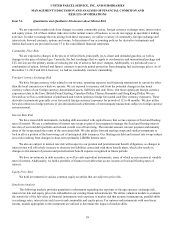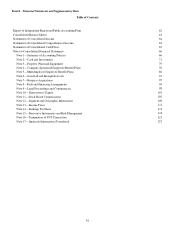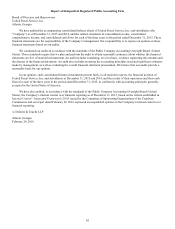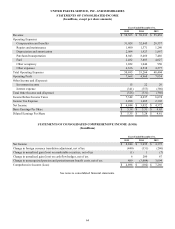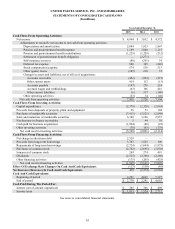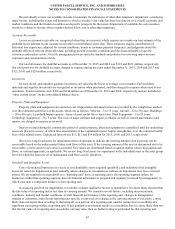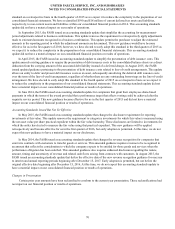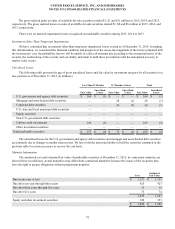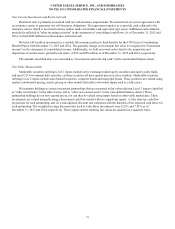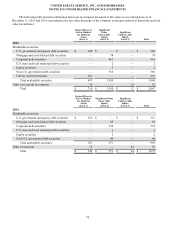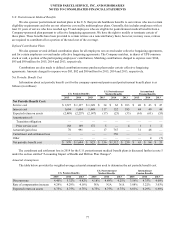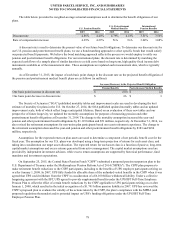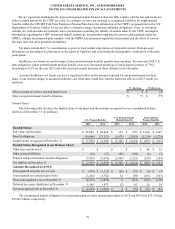UPS 2015 Annual Report Download - page 81
Download and view the complete annual report
Please find page 81 of the 2015 UPS annual report below. You can navigate through the pages in the report by either clicking on the pages listed below, or by using the keyword search tool below to find specific information within the annual report.UNITED PARCEL SERVICE, INC. AND SUBSIDIARIES
NOTES TO CONSOLIDATED FINANCIAL STATEMENTS
69
Foreign Currency Translation
We translate the results of operations of our foreign subsidiaries using average exchange rates during each period,
whereas balance sheet accounts are translated using exchange rates at the end of each period. Balance sheet currency translation
adjustments are recorded in AOCI. Pre-tax currency transaction gains, net of hedging, included in other operating expenses,
investment income and interest expense were $7, $14 and $76 million in 2015, 2014 and 2013, respectively.
Stock-Based Compensation
All share-based awards to employees are measured based on their fair values and expensed over the period during which
an employee is required to provide service in exchange for the award (the vesting period). We issue employee share-based
awards under the UPS Incentive Compensation Plan that are subject to specific vesting conditions; generally, the awards cliff
vest or vest ratably over a three or five year period (the "nominal vesting period”) or at the date the employee retires (as defined
by the plan), if earlier. Compensation cost is recognized immediately for awards granted to retirement-eligible employees, or
over the period from the grant date to the date retirement eligibility is achieved, if that is expected to occur during the nominal
vesting period.
Fair Value Measurements
Our financial assets and liabilities measured at fair value on a recurring basis have been categorized based upon a fair
value hierarchy. Level 1 inputs utilize quoted prices in active markets for identical assets or liabilities. Level 2 inputs are based
on other observable market data, such as quoted prices for similar assets and liabilities, and inputs other than quoted prices that
are observable, such as interest rates and yield curves. Level 3 inputs are developed from unobservable data reflecting our own
assumptions, and include situations where there is little or no market activity for the asset or liability.
Certain non-financial assets and liabilities are measured at fair value on a nonrecurring basis, including property, plant,
and equipment, goodwill and intangible assets. These assets are not measured at fair value on a recurring basis; however, they
are subject to fair value adjustments in certain circumstances, such as when there is evidence of an impairment. A general
description of the valuation methodologies used for assets and liabilities measured at fair value, including the general
classification of such assets and liabilities pursuant to the valuation hierarchy, is included in each footnote with fair value
measurements present.
We allocate the fair value of purchase consideration to the tangible assets acquired, liabilities assumed and intangible
assets acquired based on their estimated fair values. The excess of the fair value of purchase consideration over the fair values
of these identifiable assets and liabilities is recorded as goodwill. Such valuations require management to make significant
estimates and assumptions, especially with respect to intangible assets. Significant estimates in valuing certain intangible assets
include, but are not limited to, future expected cash flows from acquired users, acquired technology, and trade names from a
market participant perspective, useful lives and discount rates. Management’s estimates of fair value are based upon
assumptions believed to be reasonable, but which are inherently uncertain and unpredictable and, as a result, actual results may
differ from estimates. During the measurement period, which is one year from the acquisition date, we may record adjustments
to the assets acquired and liabilities assumed, with the corresponding offset to goodwill. Upon the conclusion of the
measurement period, any subsequent adjustments are recorded to earnings.
Derivative Instruments
All financial derivative instruments are recorded on our consolidated balance sheets at fair value. Derivatives not
designated as hedges must be adjusted to fair value through income. If a derivative is designated as a hedge, changes in its fair
value that are considered to be effective, as defined, either (depending on the nature of the hedge) offset the change in fair value
of the hedged assets, liabilities or firm commitments through income, or are recorded in AOCI until the hedged item is recorded
in income. Any portion of a change in a hedge’s fair value that is considered to be ineffective, or is excluded from the
measurement of effectiveness, is recorded immediately in income.
Adoption of New Accounting Standards
In November 2015, the Financial Accounting Standards Board ("FASB") issued an accounting standards update that
simplifies the presentation of deferred tax assets and liabilities. The update removes the requirement to separate deferred tax
liabilities and assets into current and non-current amounts in a classified statement of financial position. The update permits the
entity to present deferred tax liabilities and assets as non-current in a classified statement of financial position. The new
guidance would have become effective for us in the fourth quarter of 2016; however, we have elected to early adopt this


